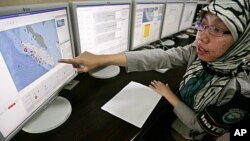On Wednesday, 20 countries participated in a major Indian Ocean-wide tsunami drill aimed at testing a new tsunami warning system. The new system will shift responsibility from United States and Japan to the countries most at risk in the region.
Wednesday's drill marked a significant development for the ability of countries in the Indian Ocean region to detect and respond to earthquakes and tsunamis. Stuart Weinstein, the deputy director of the United States' Pacific Tsunami Warning Center in Hawaii says the warning centers participating in the drill in Indonesia, India and Australia did not exist before the 2004 Tsunami that killed more than 200,000 people in 12 countries.
"At the time of the great Sumatra earthquake in 2004 there was no capability in the Indian Ocean region for a tsunami hazard. Basically there were no warning centers and that is one of the reasons there were so many casualties," said Weinstein.
Since then he says new networks of land-based seismic stations, deep water pressure sensors and warning centers have been developed throughout the region.
The drill, organized with the support of United Nations Educational, Scientific and Cultural Organization's Intergovernmental Oceanographic Commission, simulated the 2004 Tsunami. It started with a mock earthquake off the coast of Sumatra, triggering a virtual tsunami wave that crossed the Indian Ocean in 12 hours. The test included the evacuation of coastal communities in several countries, including India and Malaysia.
This time, the tsunami advisories passed through the local warning centers in the region to evaluate how well the new system functions.
The new Indian Ocean Tsunami Warning System replaces a makeshift system put in place soon after the 2004 Tsunami by the United States and Japan.
Weinstein says the new system should also be able to provide more accurate information regarding the time a tsunami wave will hit a particular area and how wave size may vary for different regions in the tsunami's path.
"Countries will look at these products and they will take a look and [ask], 'Well am I in a major threat, like is the tsunami wave expected to be greater than three meters?' If that is the case then you certainly want to consider some sort of evacuation," he said.
UNESCO officials say a complete evaluation of the drill will take weeks. If successful, the Indian Ocean Tsunami Warning System will soon take over primary responsibility for the region.
Indian Ocean Tsunami Drill Tests New Regional Warning System







